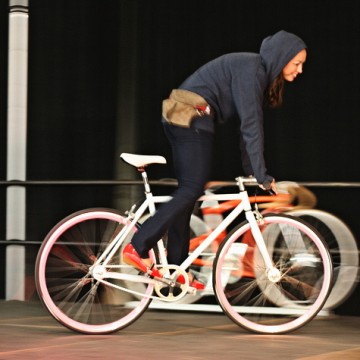Portland’s Bike Plan Makes Biking Safer in the City
Wednesday, August 27, 2014

Photo Credit: Richard Masoner / Cyclelicious via Compfight cc
Well, fear no more. Designated bike boulevards and greenways which prioritize cyclists and pedestrians over motorized traffic are being built all over town, thanks in large part to the Portland Bureau of Transportation’s (PBOT) Bicycle Plan for 2030. These mild-mannered tree-lined streets belie a cyclist’s superpower when it comes to both enjoyment and safety when getting around town by bike. Safer routes offer greater comfort and therefore more enjoyment while riding.
What is PBOT's plan for 2030?
The plan aims to decrease automobile traffic in the city by creating safer neighborhood streets that favor bike riding. Improvements to these streets to support cycling include speed bumps, directional signs listing nearby destinations, strategic stop signs which favor pedestrians and bikes, and “sharrow” markings that indicate the presence of bicycle traffic and remind motorists to share the road.
Additional benefits greenways offer are the often beautiful and functional street-side bioswales, which help divert storm runoff which taxes the city’s sewer system. Busy street crossings are being retrofitted with extended pass-through medians which alert drivers in cross traffic to the presence of pedestrians and bikes; many feature special flashing signals to demand drivers stop and allow safe passage.
Greenway routes already cover much of close-in Portland, as well as north, northwest, northeast and southeast of downtown. Over the next few years, PBOT plans to further expand the presence of neighborhood greenways throughout outer East Portland.
One huge development PBOT has slated for fall 2015, is a 4.8-mile north-south boulevard on 130th Avenue, which will connect the Springwater Corridor Trail to the I-84 multi-use path. The Springwater Corridor Trail—one of the most popular paved trails in the city that forms the southern leg of the the 40 Mile Loop—provides miles of car-free riding in southeast Portland.
Additional routes are planned east of 150th to connect outer east Portland in 2016.
Bike boulevards and greenways will increase
Perhaps the most ambitious goal in the Bicycle Plan is the goal to increase the number of bike boulevards and greenways within one half mile of every Portland residency from just under 25 percent to 80 percent Even now, in central and close-in neighborhood with high bicycle traffic, most residents have only to bike for a couple of blocks before accessing a bikeway.
Although greenway creation has slowed over the past couple of years due to PBOT revenue constraints, and the lack of local funding for neighborhood bike boulevard construction, federally funded greenways are still being added. With over 70 percent of city streets running through residential neighborhoods, designating bike boulevards makes sense from a cycling-friendly perspective.
PBOT offers city maps with detailed greenway and bike path information online. You can also order printed maps from the website or pick one up at most major bike shops, REI, and BTA offices. The maps are free of charge.
If you already know your way around and want to plan a trip across town but don’t have a map, finding your way couldn’t be easier. Ride just a few blocks in nearly any direction and you’re sure to find a greenway, as indicated by the green directional street signs with a bicycle at the top, sharrows painted on the street or these artistic . But perhaps the biggest tip-off you’ve rolled onto a bike boulevard are the number of smiling, happy, healthy people on bikes heading in the same direction.
Photo Credit: Richard Masoner / Cyclelicious via Compfight cc
Üma Kleppinger is a Portland-based copy writer and advocate for full-contact anti-bummer living. She is a recovering sesquipedalian who writes about life in the saddle and outdoor adventure. She is also the author of BikeYoga, a yoga program for cyclists. When not writing, she can be found riding and racing her mountain bike throughout the Pacific Northwest.




Follow us on Pinterest Google + Facebook Twitter See It Read It